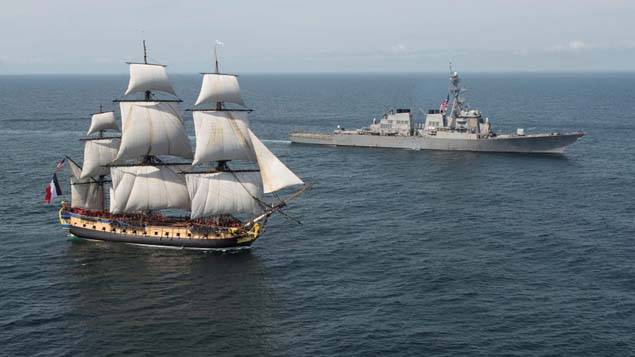The Hermione reach the USA coast. She sails as fast as the original close to 14kts. I will love to go on her. I have heard on the radio that it needed no less than 80 crews to sail her.
photo from © MaxPPP
The original "Hermione" was built in the 18th century for General Lafayette. Her purpose was to go to the USA to fight against the English during the independance war.
It tooks 17years to rebuilt an exact replica of the ship in the same town where the original was made; this is very close to my hometown. The original only took 11months to be built.
The ship will mainly navigate by sail but for safety reason and harbor handling, two pod unit have been fitted.
Before to come to Japan, I was working at Sealine in the UK. The F380 is the latest model I have worked on. This boat has won the Motor Boat award 2015.
I have worked on the GA, the modified hull from the SC380 and produced the 3D model and structure calculations for the superstructure. I am glad this small flybridge has been appreciated by the industry. It is very hard to produce sub 40ft flybridge with the right level of quality and equipment within the tight budget required for clients. It tooks a while for it to be produced due to change of ownership at the yard but the result is great.
Moving boat from yard to the sea or a boat show is always an interesting process.
I have been living when child close to boatyard inland where we can see boat going on the road daily. In Japan, it seems easier to sail boat from one port to another rather than moving on the road.
I have found example of a Feadship superyacht in Holland going to refit and a Lagoon catamaran going to the Paris boatshow.
For planning yacht a classical overhanging bow is the most popular but we can see more and more vertical, reverse, x-bow and many others on new boats and concept.
They all have their own qualities but they may not apply to planning yacht. Most of them have been created for commercial or military boats with a total different application than cruising yacht The choice of the bow design is often coming from client or brand who would like to have boat that stand out from competitor.
For example the vertical bow is now an most of the modern sailing yacht and gives a more agressive look. On sailing yacht it has the advantage to increase the waterline to the maximum length of the boat. So for an equivalent length boat, the one with vertical bow will be able to go faster. This is only true because the yacht is not planning and it is also helping to obtain better rating against race's rules.
However for planning powerboat, it does not have the same effect. The planning surface of the boat is at the back and the bow is mostly out of water all the time. The negative part of vertical bow is that it does not deflect waves in formed sea so you generally have lot of water coming into the boat!
One advantage of a vertical bow is that you can design a boat with a lower LOA than competitor but with the exact same BOA and interior layout. This way your smaller boat looks like a bigger one!
However if you try to design an elegant slim yacht the vertical bow will have for effect to reduce the beam in way of the foward cabin which could be a problem for customers used to wide double bed.
Personnaly, I believe that all solutions are applicable to cruising yacht as long as the customer understand beforehand the consequence of its choice on the its future navigation.